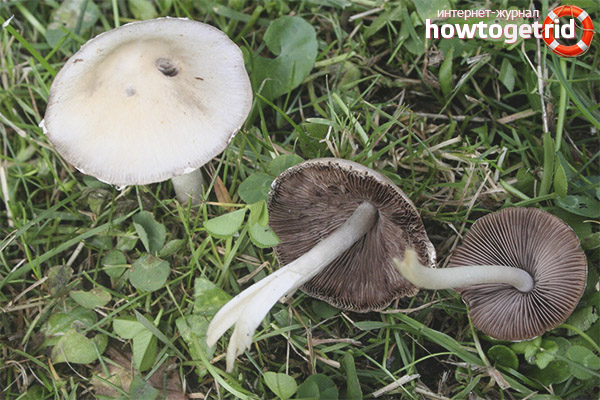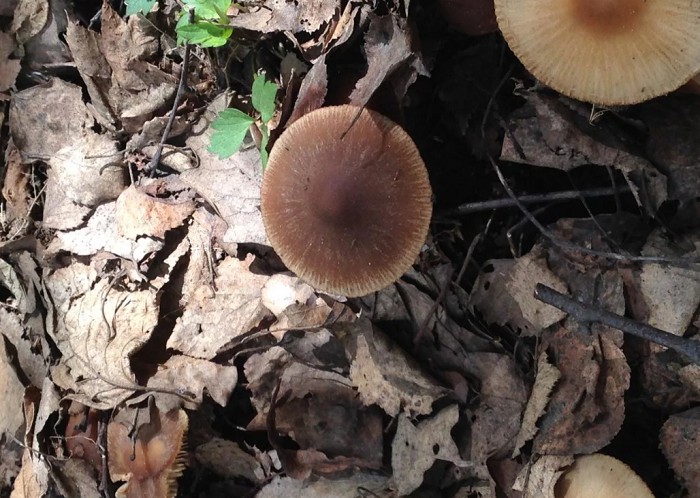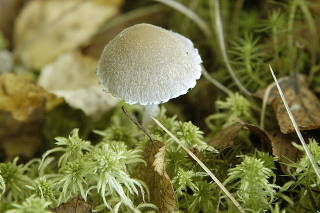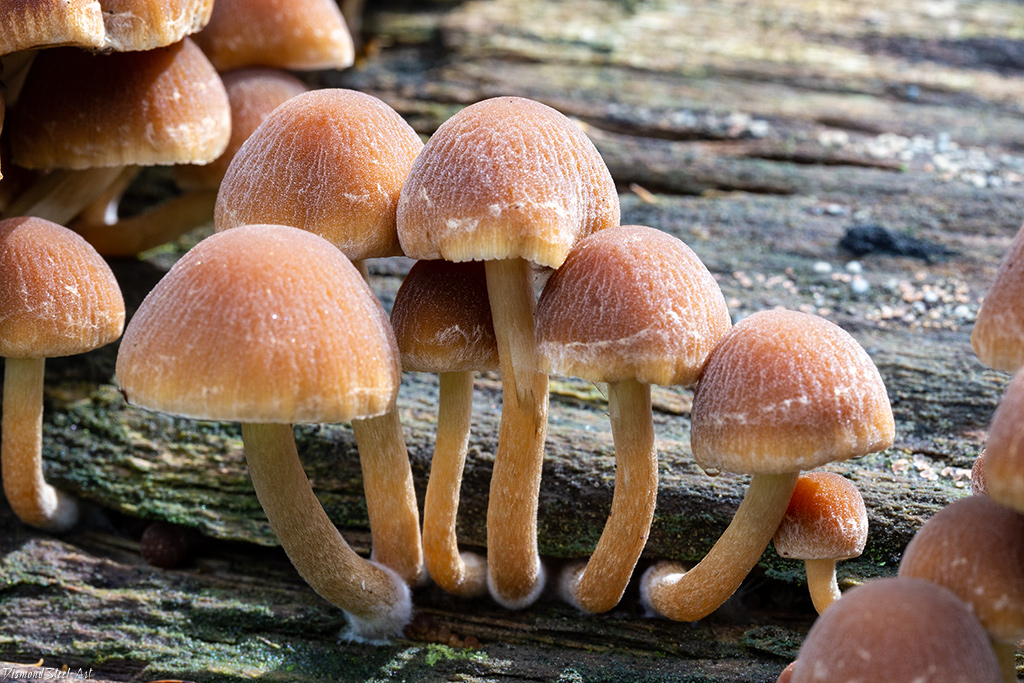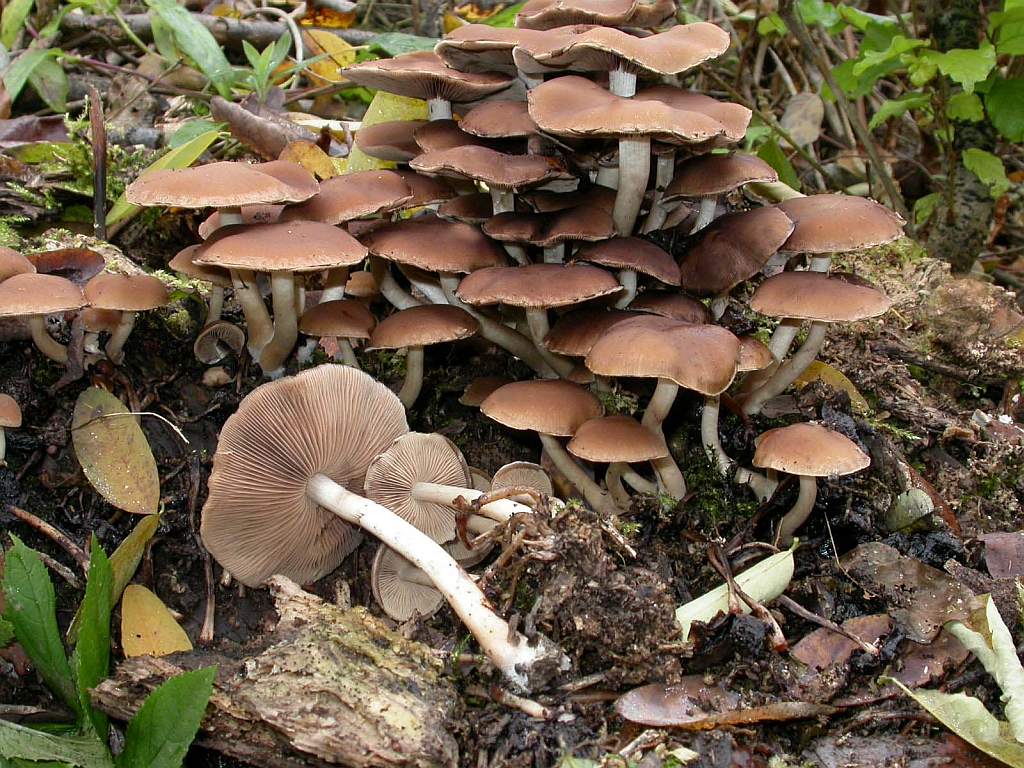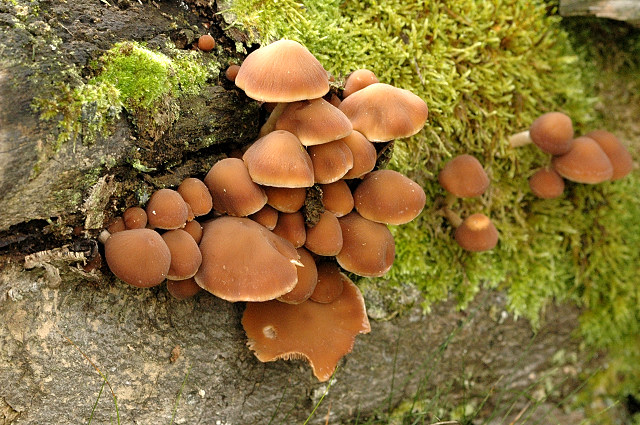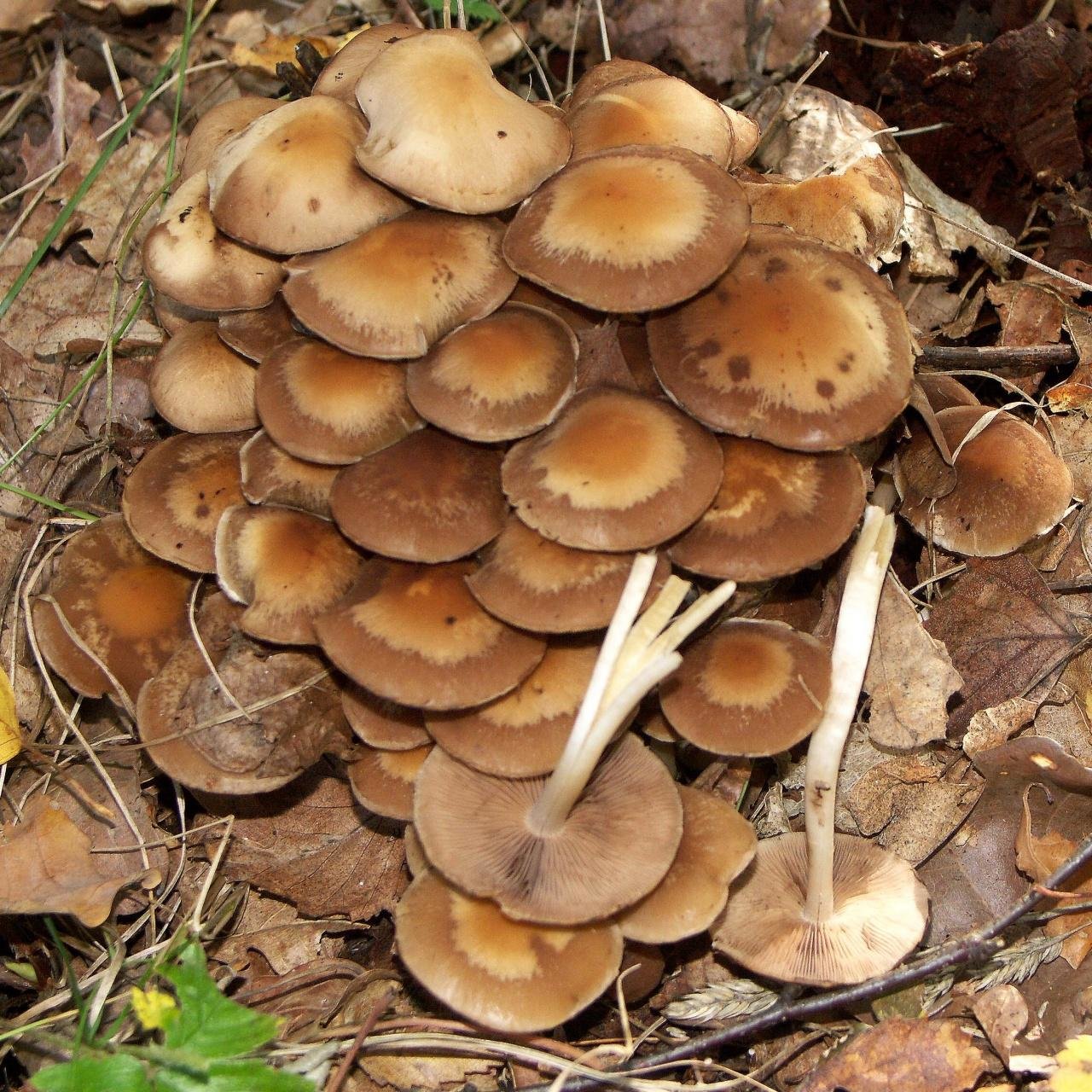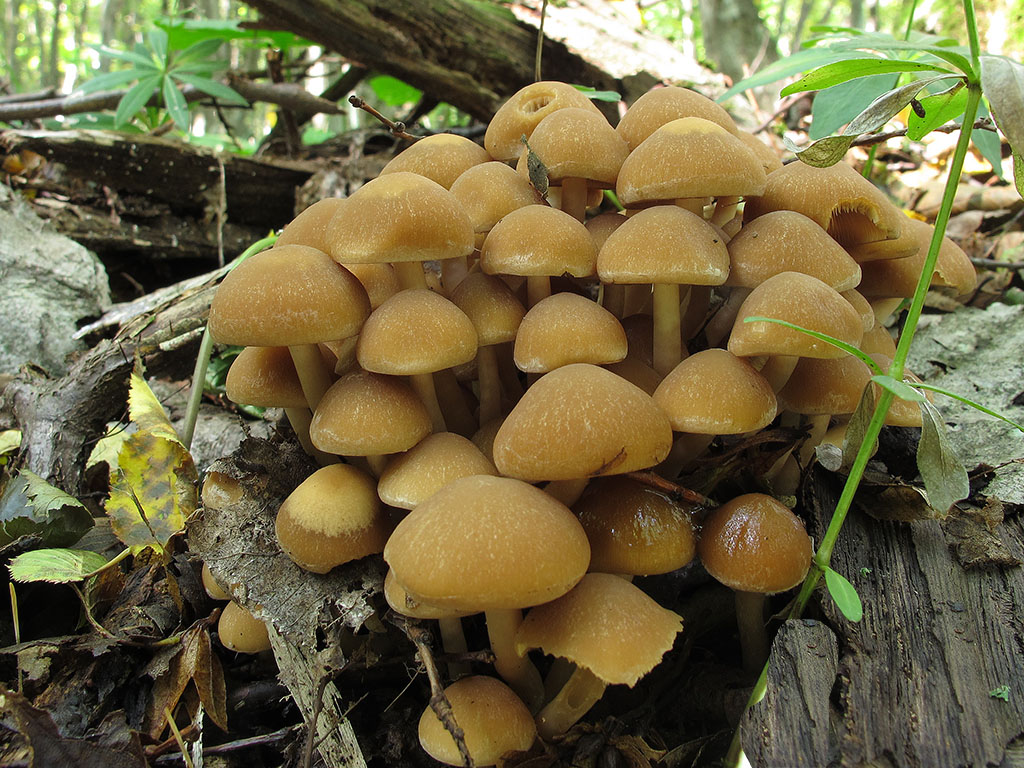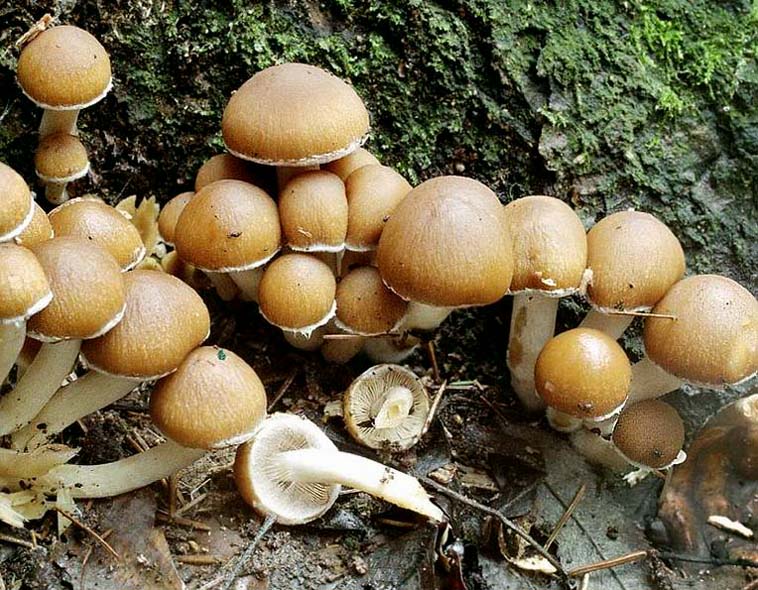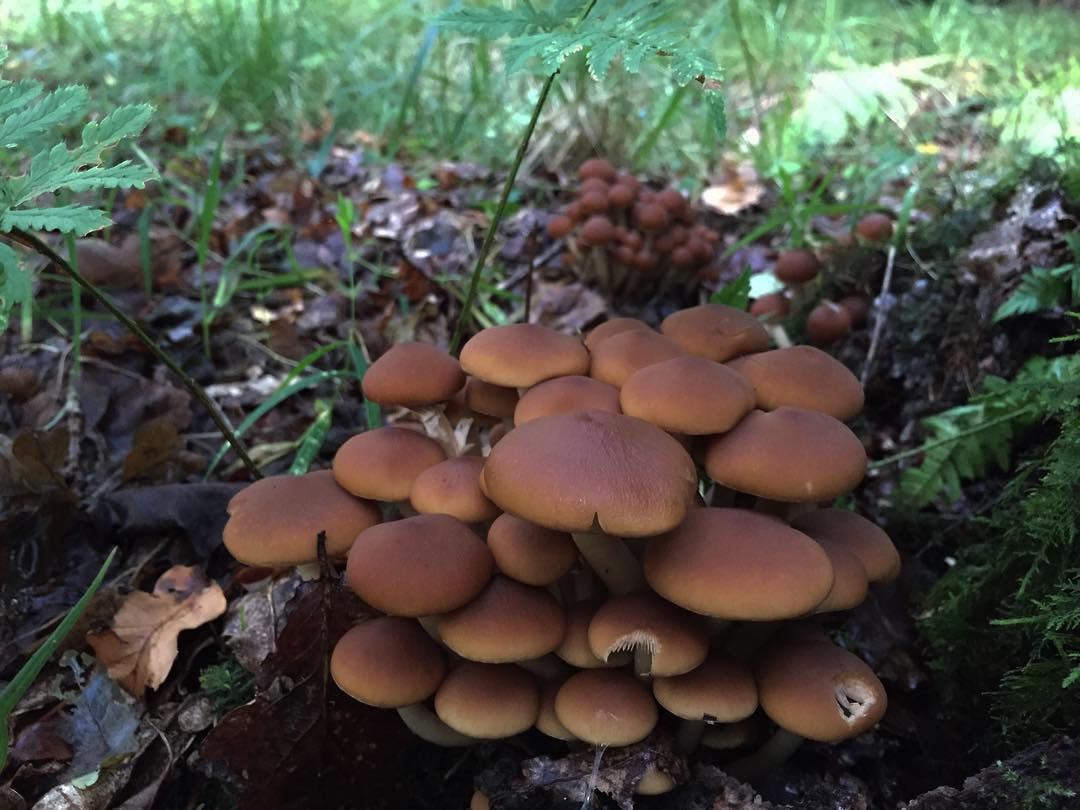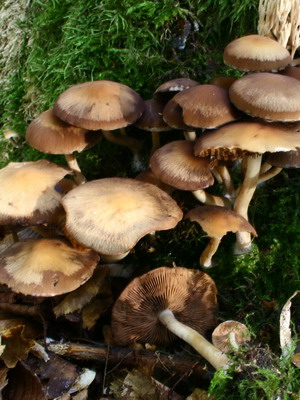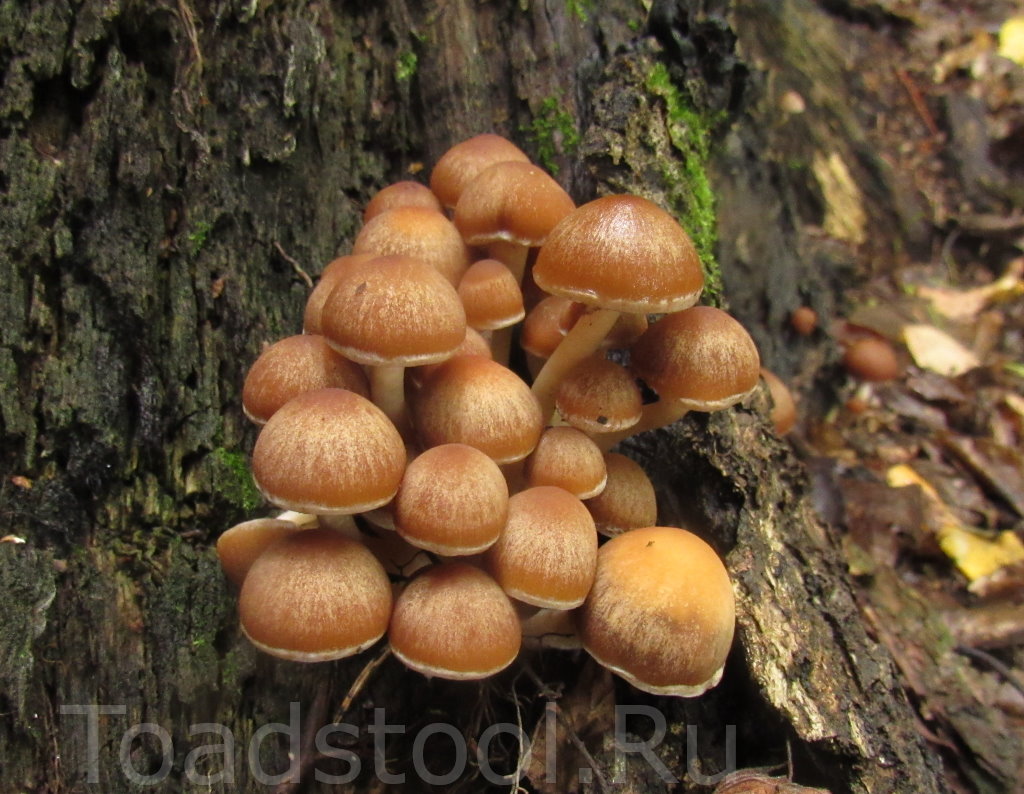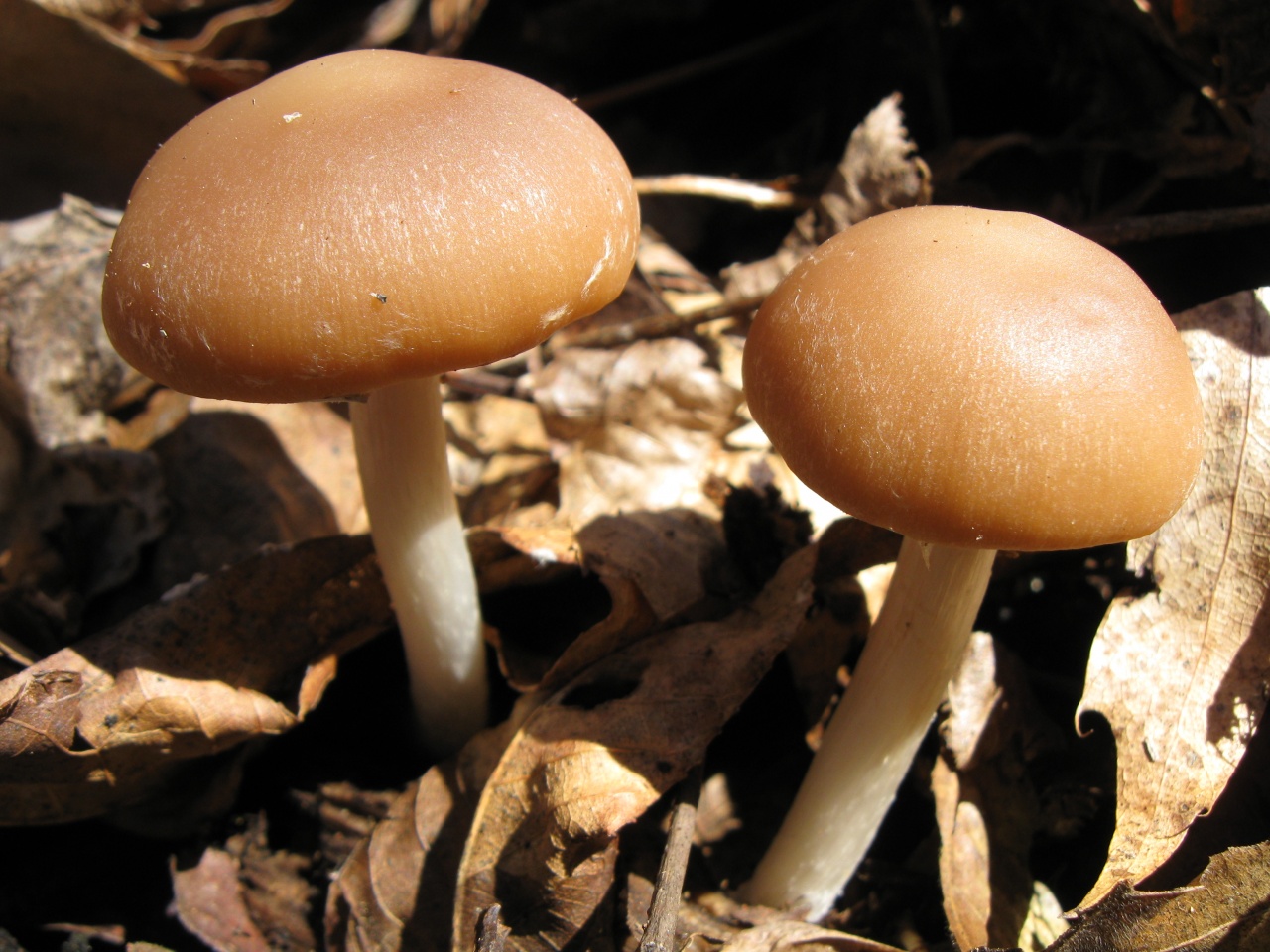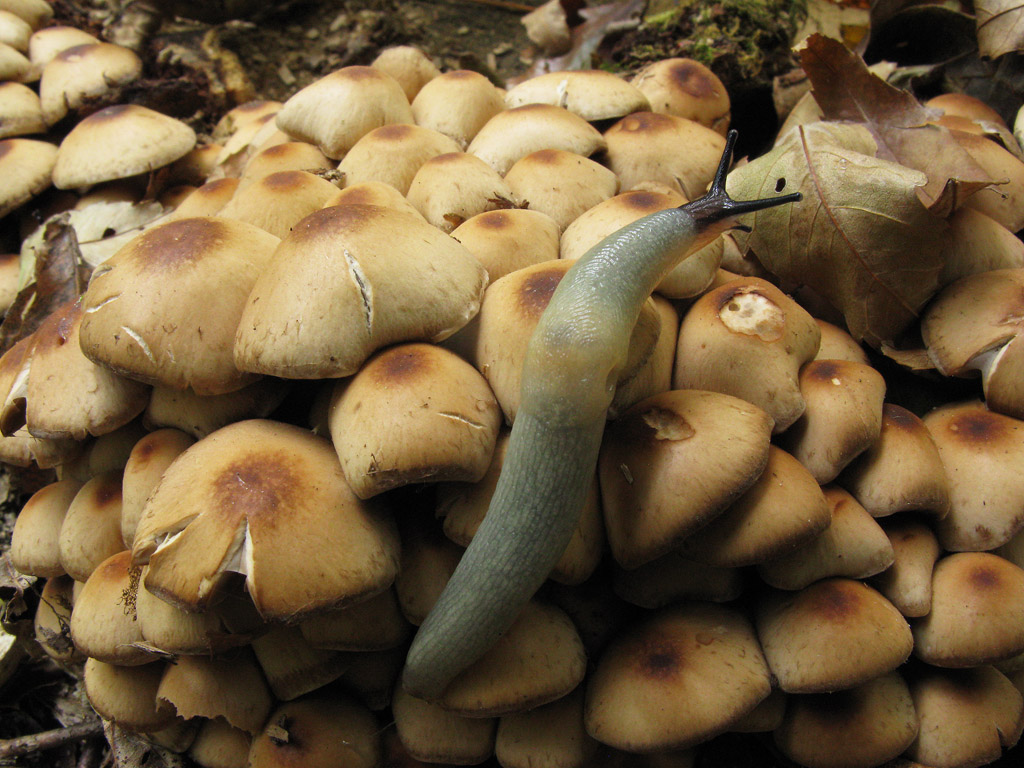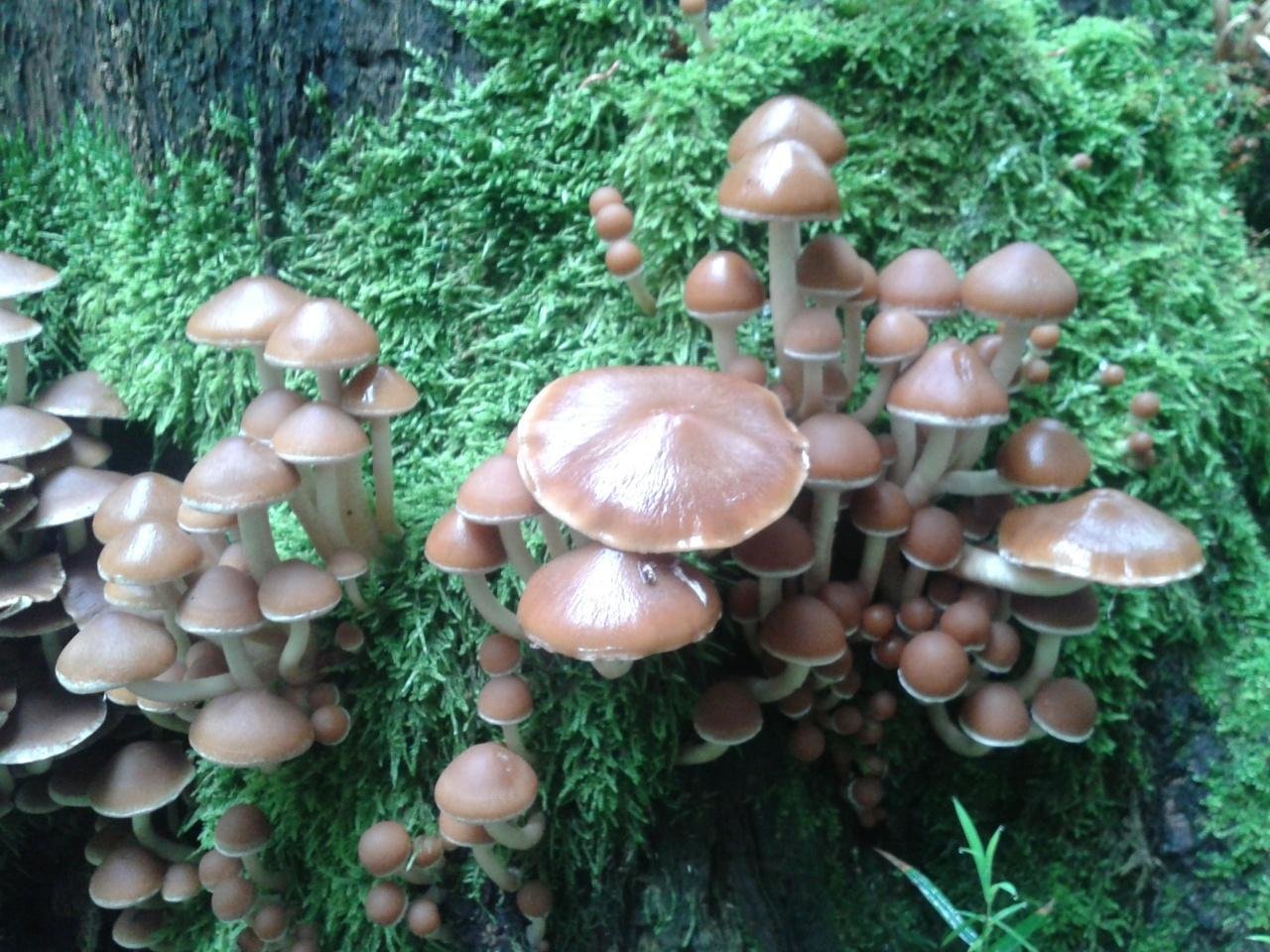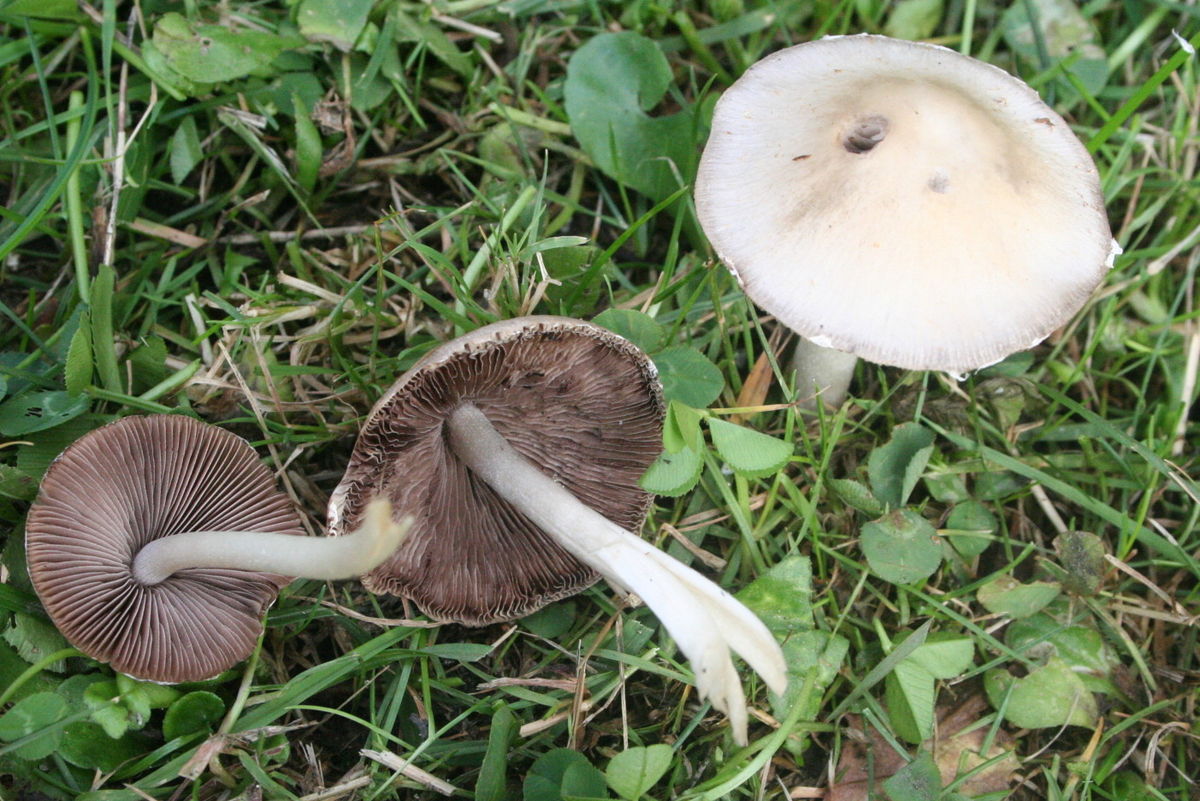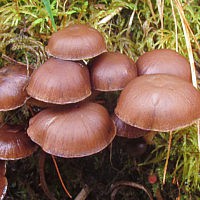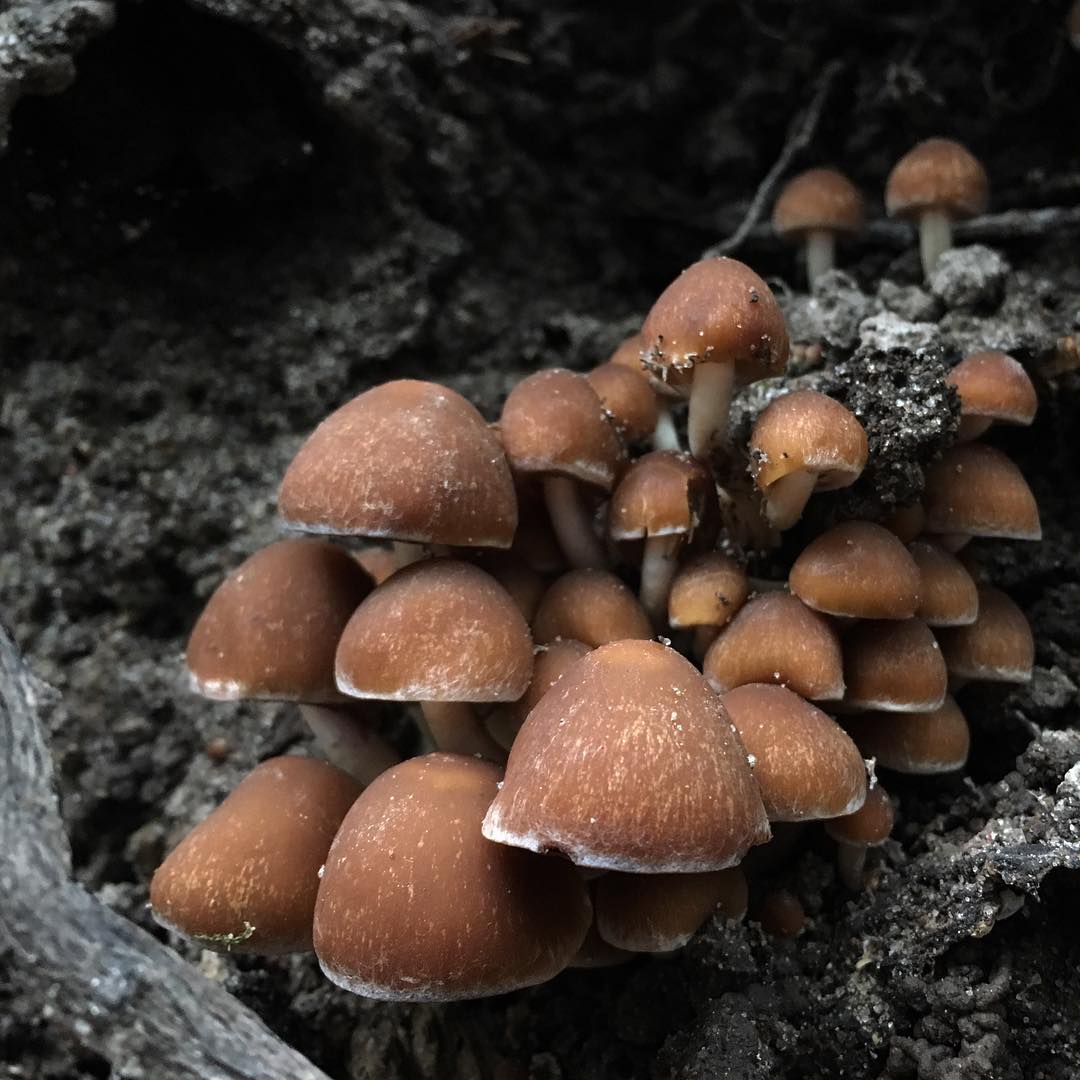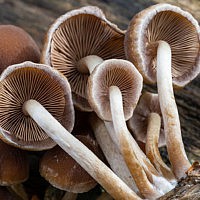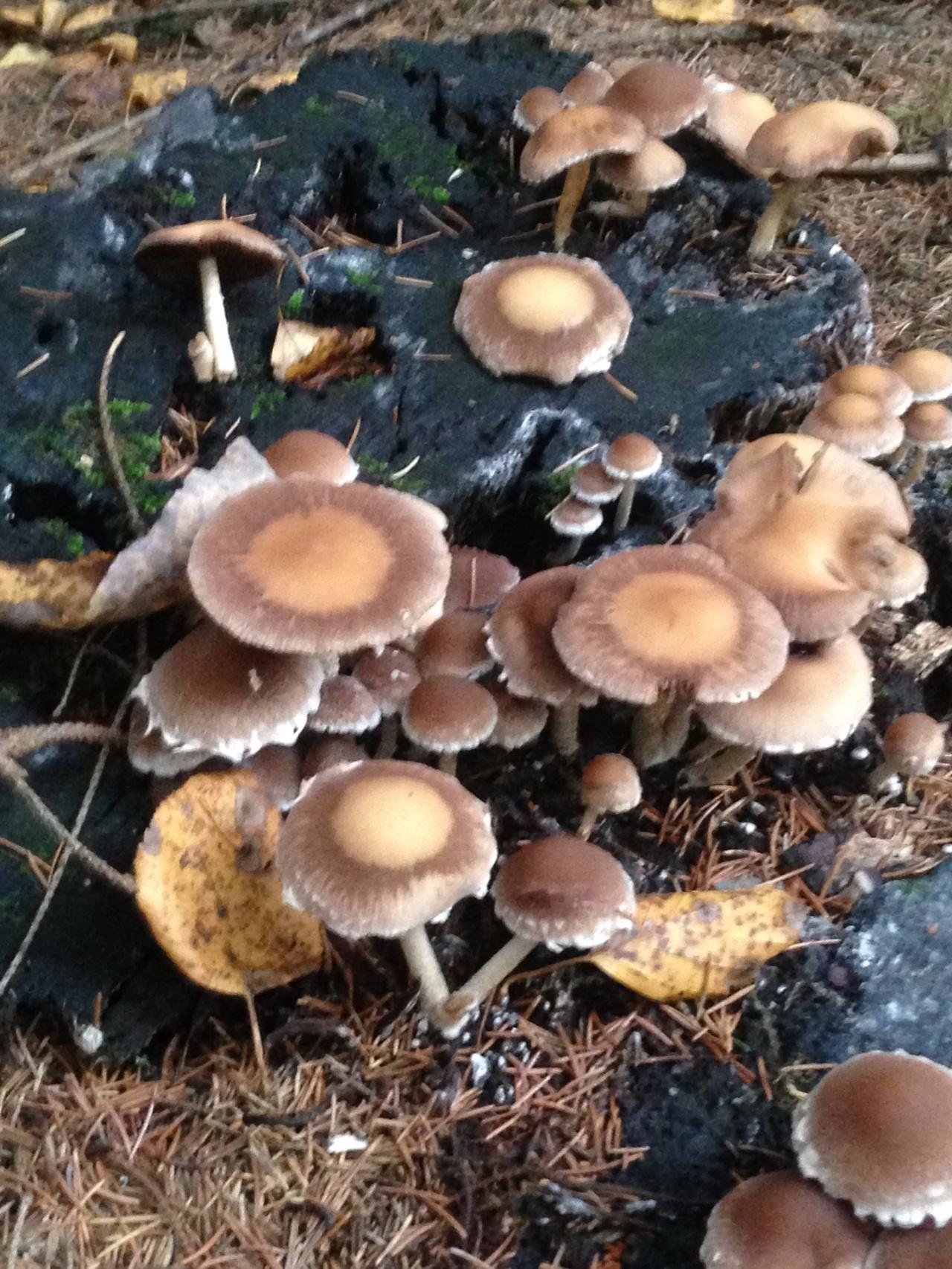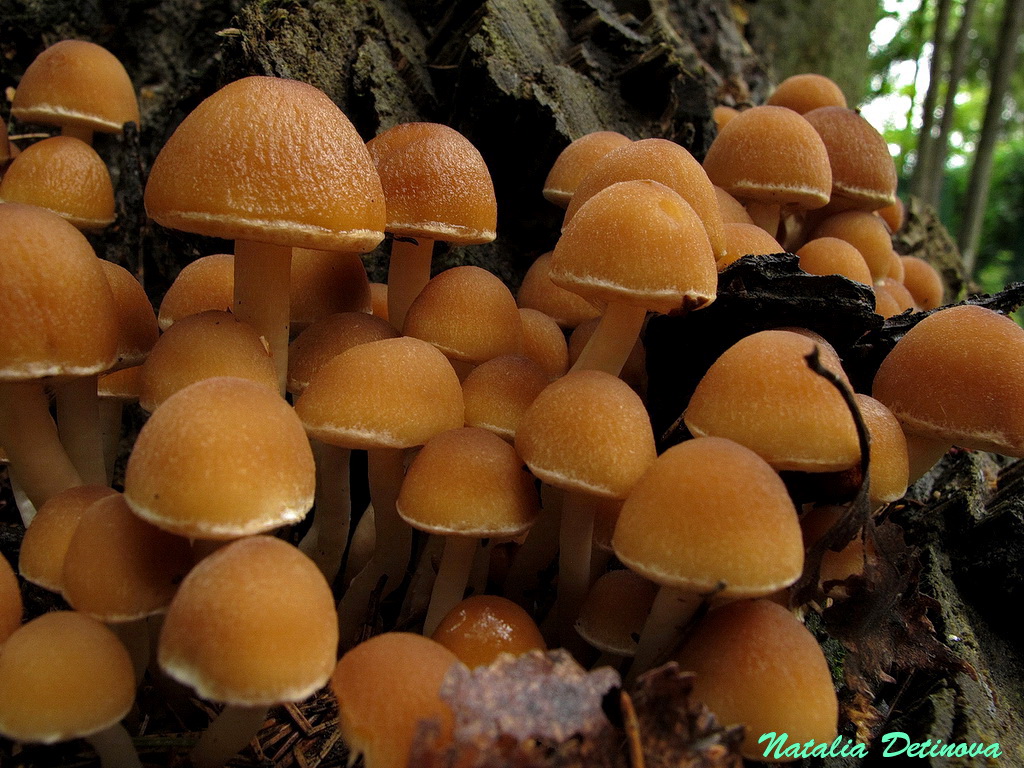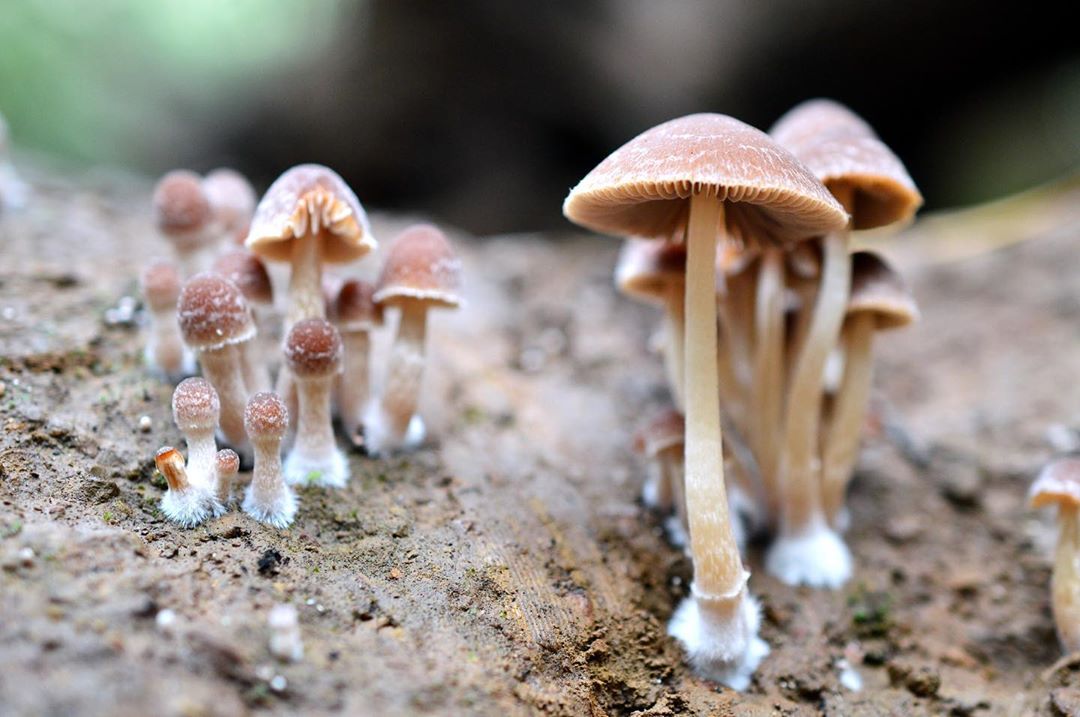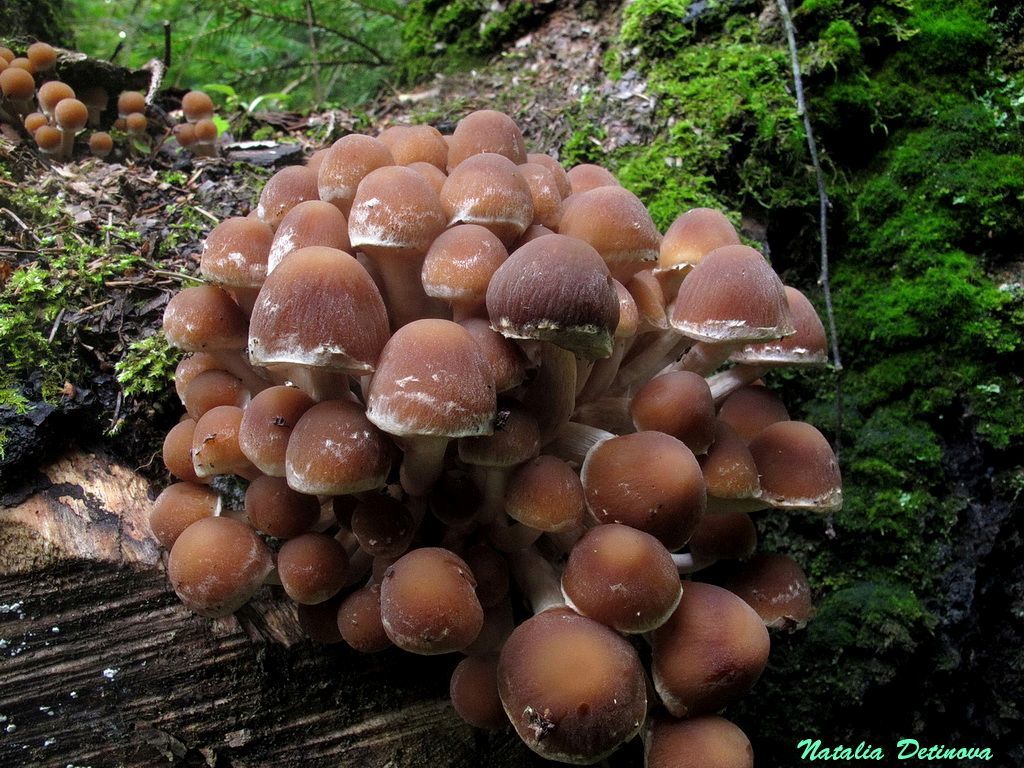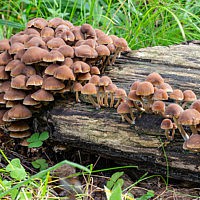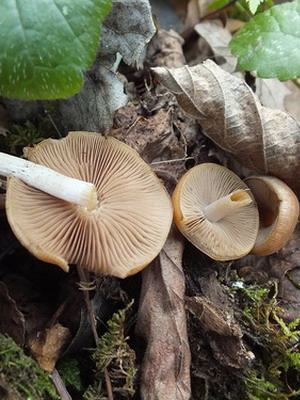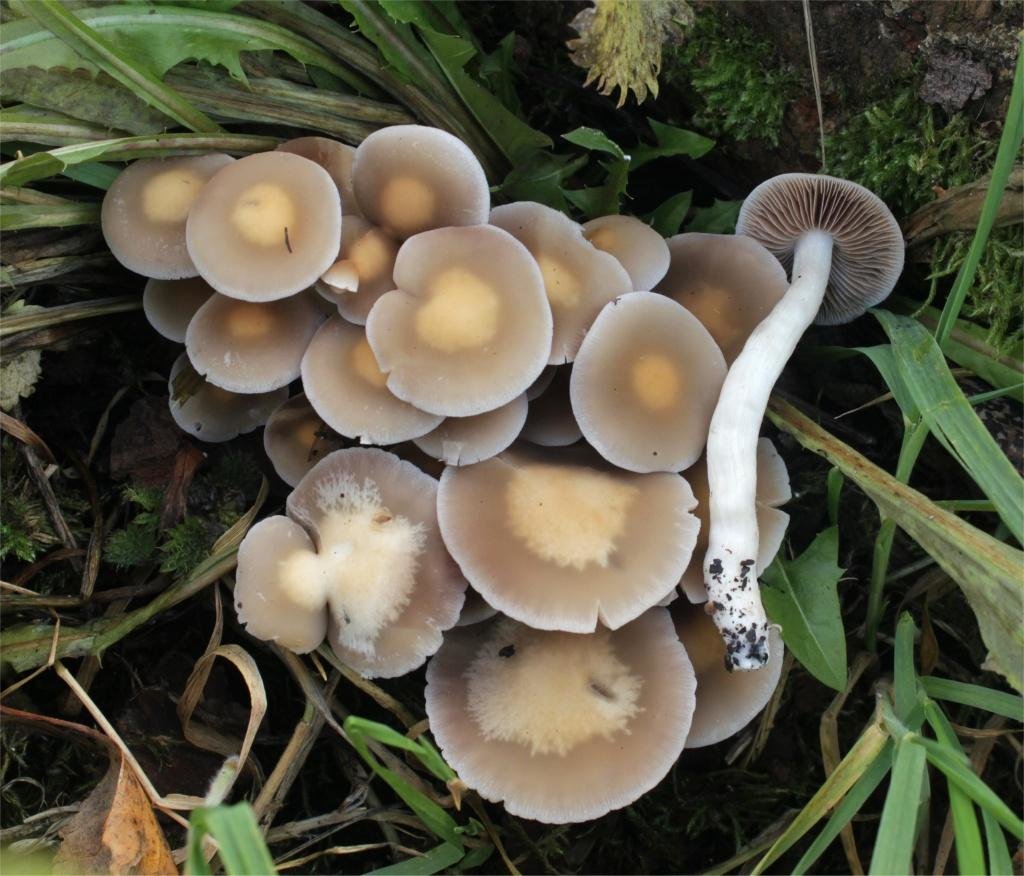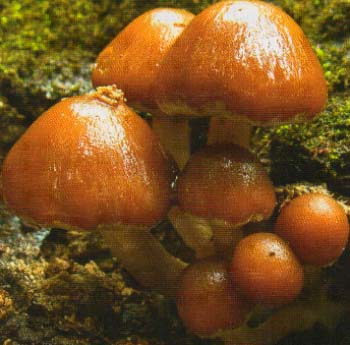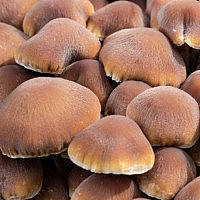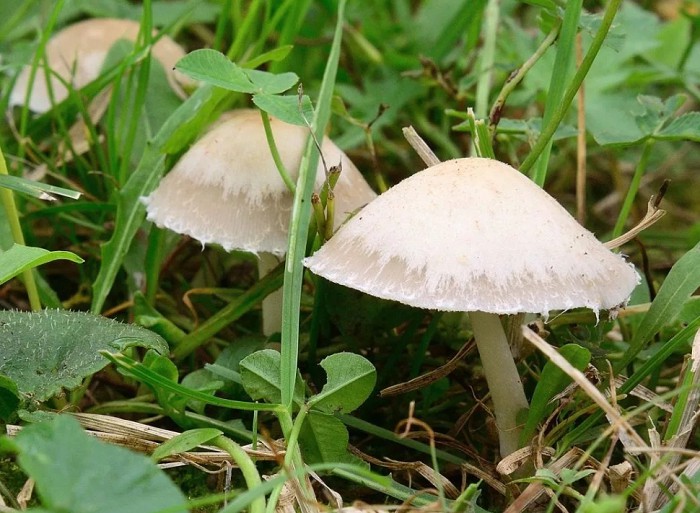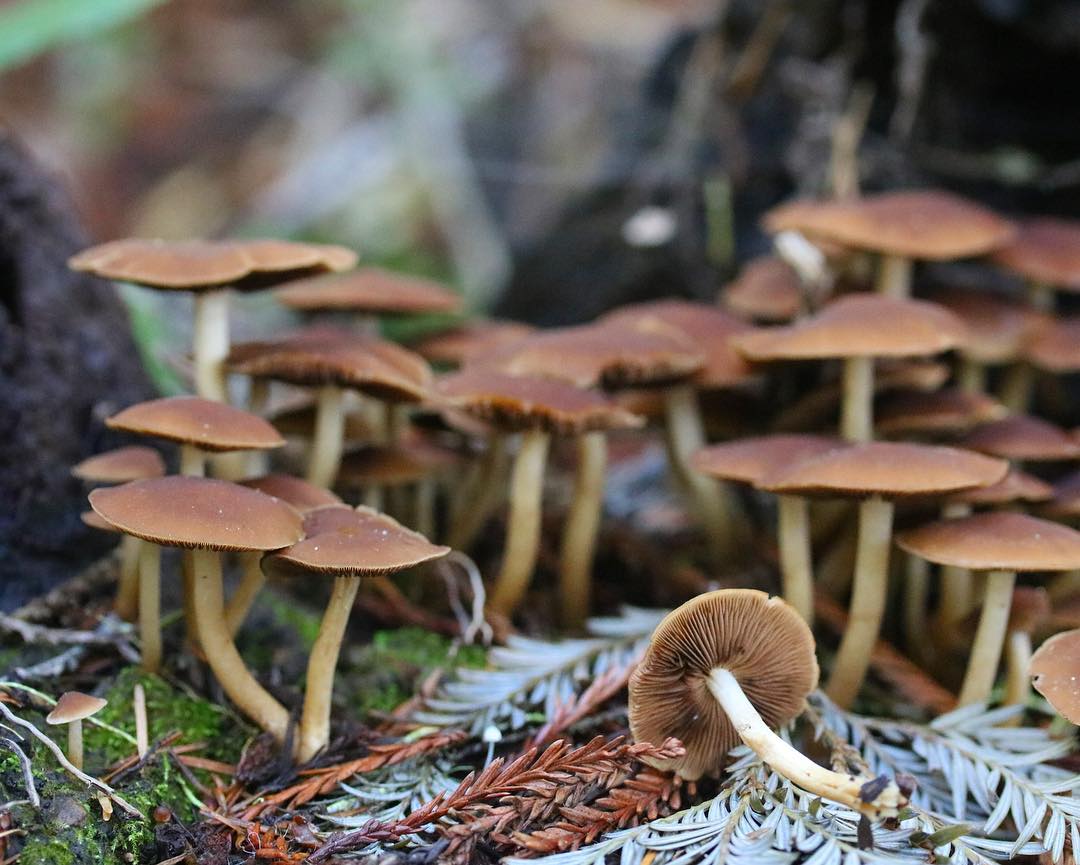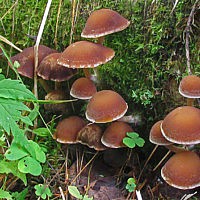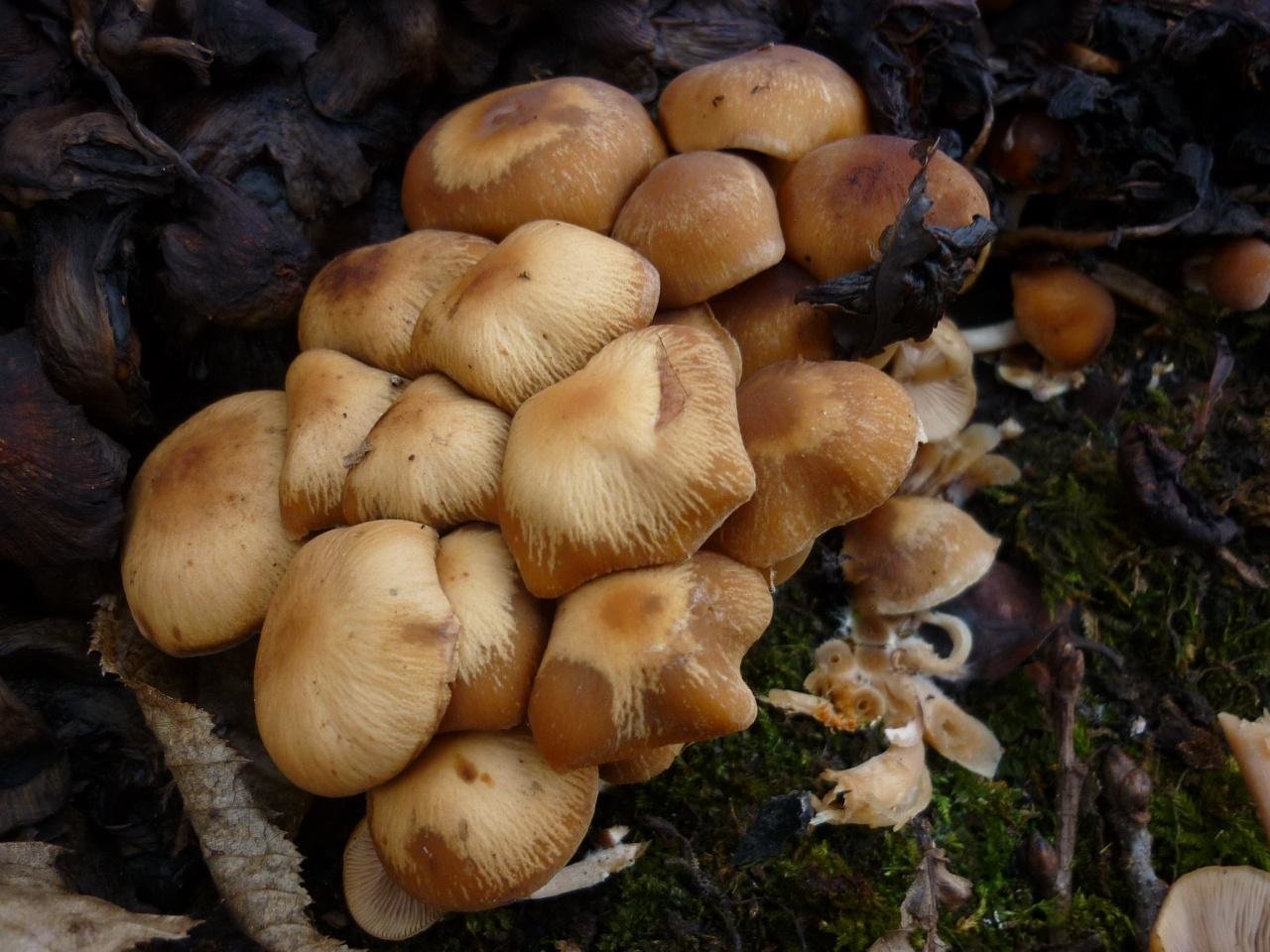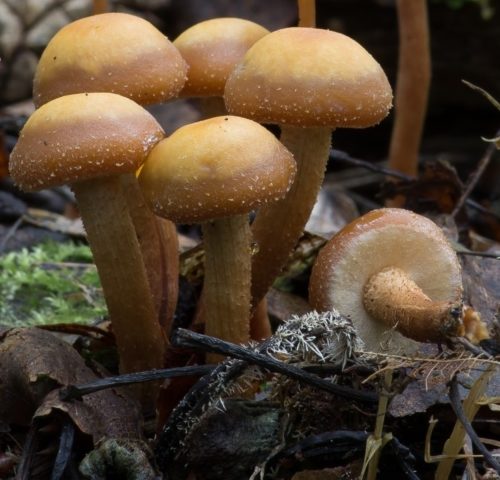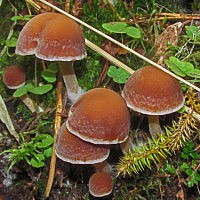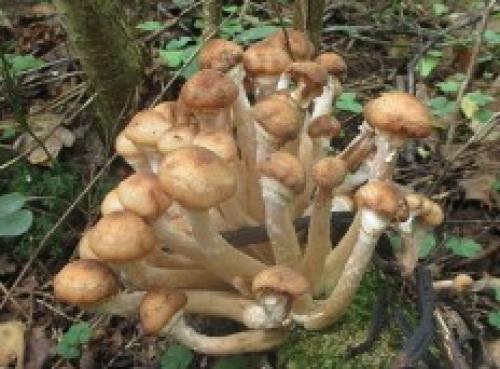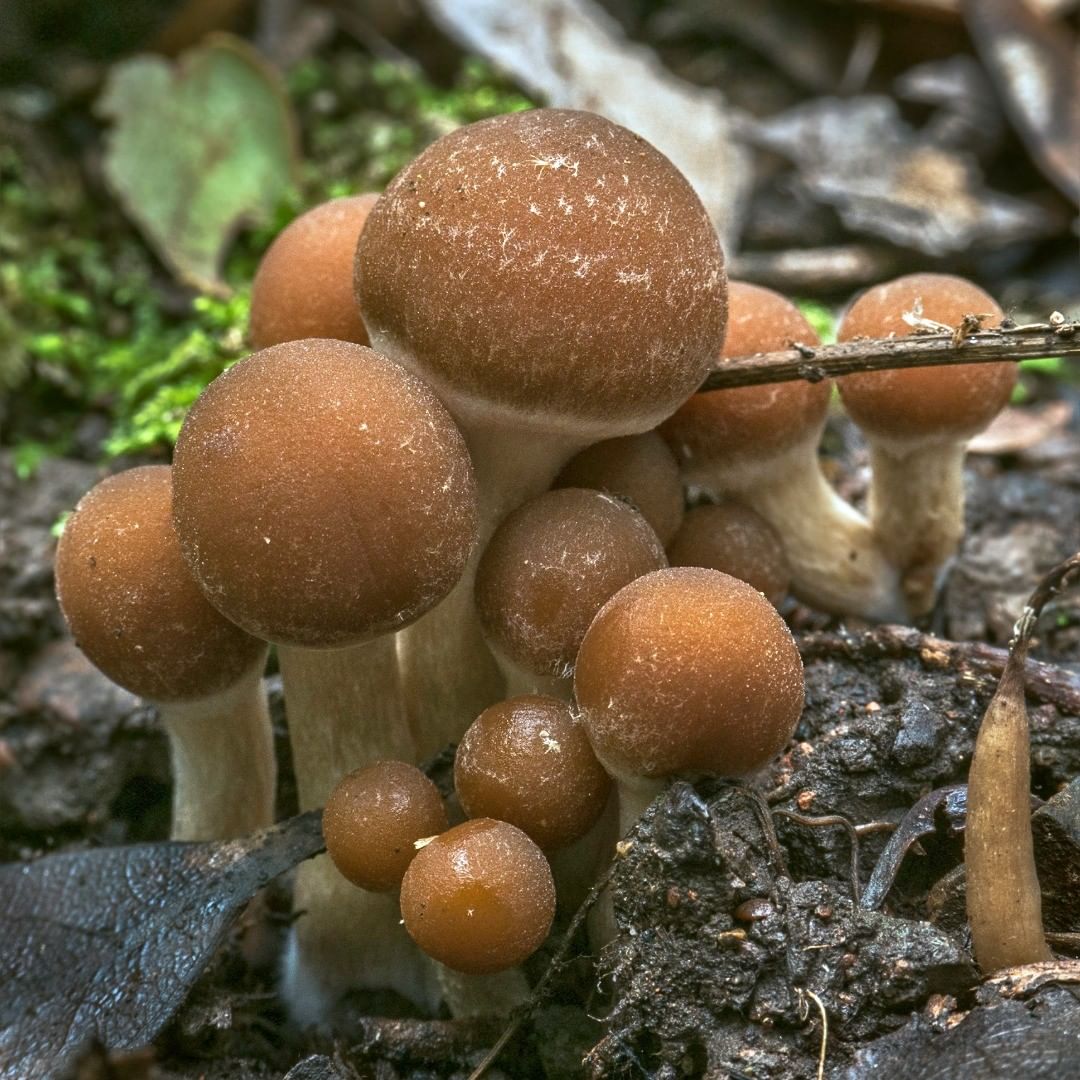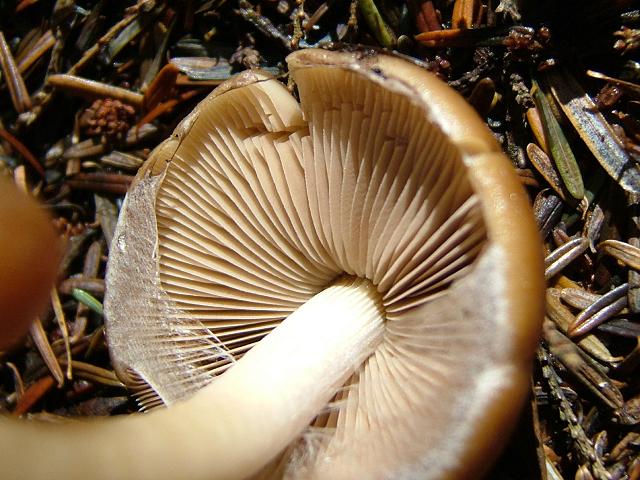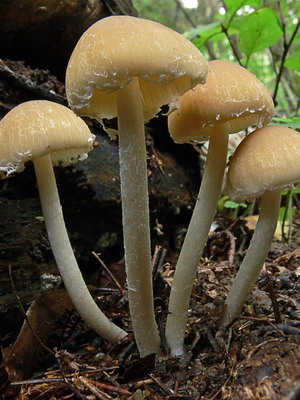Morphology
The fruiting bodies are small or medium-sized, with a central stem position.
The cap is thin, hygrophane, at first spherical, bell-shaped or cone-shaped, can open up to flat, the edges are often grooved, the color is from whitish to various brown shades.
The pulp is thin, fragile.
The stem is long and thin, brittle, fibrous, with a cavity, usually the same color as the cap or lighter in color. The surface can be felt or scaly.
adherent or loose, light at first, then darkening and becoming brownish, violet-brown or black, usually with a lighter edge.
The remains of the bedspread are noticeable on the surface and especially along the edges of the cap, cobweb or filmy, the ring and volva are usually absent, there is rarely a ring on the leg.
Dark brown, purple or almost black spore powder.
Spores are dark purple to black, usually smooth, with occasional germination. There are cheilocystids, their shape can be varied: bottle-shaped, saccular, clavate, with a coracoid outgrowth, sometimes inlaid with crystals.
Description of psatirella gray-brown
At a young age, these mushrooms have hemispherical caps. The hat of the gray-brown psatirella is rather compact. As it grows, it opens up and becomes almost prostrate. Its diameter ranges from 3 to 6 centimeters. In young mushrooms, the caps are overgrown with a light fringe, which is the remnants of the bedspread. In dry weather, the edges often crack.
In mushrooms with thin-fleshy caps, a small tubercle is very rarely seen in the center. The color of the surface of the cap is variable, like that of many members of the genus. The color of the cap depends on the weather conditions and can be easily changed.
The surface of the cap can take on various shades of brown and gray. And in dry weather, the cap, in general, fades to a yellow or clay color. The zoning of color is clearly visible.
The flesh of gray-brown psatirella is thick, watery and brittle. The color of the pulp is whitish. The pulp has a pleasant mushroom aroma.
The plates are rather wide, often adherent. The color of the plates in young specimens is light cream. In adult mushrooms, spores mature, and therefore the plates become dark - brown or even black. But the edges of the plates remain light. The spore powder is dark brown.
In comparison with other representatives of the genus, the leg of the gray-brown psatirella is rather thick. Its height ranges from 4 to 8 centimeters, and its diameter reaches 0.8 centimeters. The shape of the leg is cylindrical, inside it is most often hollow. The color of the leg is whitish. The leg is located in the center of the cap. Its base is wavy-pubescent, white, and closer to the blades, there is a mealy white bloom. The surface of the leg is scaly.
Areas of growth of gray-brown psatirella
These mushrooms begin to meet in early May. Psatirellas bear fruit in gray-brown waves, the last peak is observed in mid-October.
Gray-brown psatirella grow on rotting wood. They settle in rather scattered groups, sometimes they can form dense clusters.
Other mushrooms of this genus
There are a huge number of species in the Psatirella genus, and the appearance of all these mushrooms is very changeable, so it is very difficult to understand them. The easiest way to identify the gray-brown psatirella is that there is little competition during this period.
Psatirella globular, or water-loving - an inedible mushroom. Young mushrooms have hemispherical or bell-shaped caps, then they become semi-spread. Scraps of bedspread are often visible along the edges of the cap. The diameter of the cap is 2-6 centimeters. The structure of the cap is hygrophane, that is, it absorbs moisture.
In wet places of growth, the color of the caps is chocolate, and in dry places it is creamy.The leg is hollow, smooth, no more than 8 centimeters high and 0.7 centimeters thick. The color of the leg is whitish. There is a false ring at the top of it.
Psatirella globose grows on woody remains, also settles on stumps, and on the soil around them. These mushrooms grow in large colonies, forming bundles. Fruiting occurs in June-October. This mushroom is not considered poisonous, but it is also not edible.
Psatirella cotton is an inedible mushroom. At a young age, the shape of the cap is conical or hemispherical, but over time it becomes prostrate. The surface of the cap is variegated, cracking. The skin covering the cap is brownish-gray. Remnants of the bedspread are visible along the edges of the cap. The leg is cylindrical, scaly, its length is 3-6 centimeters. The upper part of the stem is white and the lower is darker.
These mushrooms are not found too often. They mostly grow in dry spruce forests. You can find them in the middle of autumn. Quilted psatirella settle in heap groups. There is no information about their edibility.
Accepted views
- Psathyrella aquatica J.L. Frank, Coffan, & Southworth 2010
- Psathyrella ammophila (Durieu & Lév.) P. D. Orton 1960
- Psathyrella asperospora (Cleland) Guzmán, Bandala & Montoya 1991
- Psathyrella atomatoides (Peck) A. H. Sm. 1972
- Psathyrella atrolaminata Kits van Wav. 1981
- Psathyrella badiovestita P. D. Orton 1960
- Psathyrella bifrons (Berk.) A. H. Sm. 1941
- Psathyrella bipellis (Quél.) A. H. Sm. 1946
- Psathyrella borgensis Kits van Wav. 1987
- Psathyrella candolleana (Fr.) Maire 1913 - Psathyrella Candolle
- Psathyrella canoceps (Kauffman) A. H. Sm. 1941
- Psathyrella caput-medusae (Fr.) Konrad & Maubl. 1948
- Psathyrella cernua (Vahl) M. M. Moser 1984 - Fragile drooping
- Psathyrella chondroderma (Berk. & Broome) A. H. Sm. 1941
- Psathyrella clivensis (Berk. & Broome) P. D. Orton 1960
- Psathyrella conopilus (Fr.) A. Pearson & Dennis 1949 - Fragile conical, or Psatirella blackish
- Psathyrella coprophila Watling 1971
- Psathyrella corrugis (Pers.) Konrad & Maubl. 1948 - Fragile wrinkled
- Psathyrella cotonea (Quél.) Konrad & Maubl. 1949
- Psathyrella dennyensis Kits van Wav. 1987
- Psathyrella dunensis Kits van Wav. 1985
- Psathyrella echinata (Cleland) Grgur. 1997
- Psathyrella fatua (Fr.) P. Kumm. 1949 - Tasteless fragile
- Psathyrella fibrillosa (Pers.) Maire 1938 - Psathyrella fibrillosa
- Psathyrella flexispora T. J. Wallace & P. D. Orton 1960
- Psathyrella friesii Kits van Wav. 1977
- Psathyrella frustulenta (Fr.) A. H. Sm. 1941
- Psathyrella fusca (Schumach.) M. M. Moser 1952
- Psathyrella gordonii (Berk. & Broome) A. Pearson & Dennis 1948 - Psatirella Gordon
- Psathyrella gossypina (Bull.) A. Pearson & Dennis 1948 - Cotton Psathyrella
- Psathyrella gracilis (Fr.) Quél. 1872 typus - Psatirella graceful, or Fragile slender
- Psathyrella hirta Peck 1897
- Psathyrella incerta (Peck) A. H. Sm. 1972
- Psathyrella laevissima (Romagn.) Singer 1969
- Psathyrella leucotephra (Berk. & Broome) P. D. Orton 1960
- Psathyrella longicauda P. Karst. 1891
- Psathyrella lutensis (Romagn.) M. M. Moser 1955
- Psathyrella macquariensis Singer 1959
- Psathyrella maculata (C. S. Parker) A. H. Sm. 1972
- Psathyrella marcescibilis (Britzelm.) Singer 1951
- Psathyrella microrhiza (Lasch) Konrad & Maubl. 1948 - Half-covered fragile woman
- Psathyrella mucrocystis A. H. Sm. 1972
- Psathyrella multipedata (Peck) A. H. Sm. 1941 - Psatirella centipede, or Fragile many-legged
- Psathyrella murcida (Fr.) Kits van Wav. 1985
- Psathyrella narcotica Kits van Wav. 1971
- Psathyrella noli-tangere (Fr.) A. Pearson & Dennis 1948
- Psathyrella ocellata (Romagn.) M. M. Moser 1967
- Psathyrella olympiana A. H. Sm. 1941
- Psathyrella panaeoloides (Maire) M. M. Moser 1967
- Psathyrella pannucioides (J. E. Lange) M. M. Moser 1967
- Psathyrella pellucidipes (Romagn.) M. M. Moser 1978
- Psathyrella pennata (Fr.) A. Pearson & Dennis 1948
- Psathyrella phegophila Romagn. 1985
- Psathyrella piluliformis (Bull.) P. D. Orton 1969 - Psatirella water-loving, or Hydrophilic fragile
- Psathyrella ploddensis Kits van Wav. 1987
- Psathyrella polycystis (Romagn.) Romagn. 1982
- Psathyrella populina (Britzelm.) Kits van Wav. 1985
- Psathyrella pseudobifrons Romagn.
- Psathyrella pseudocasca (Romagn.) Kits van Wav. 1982 - Psatirella is oldish
- Psathyrella pseudocorrugis (Romagn.) Bon 1983
- Psathyrella pseudogordonii Kits van Wav. 1985
- Psathyrella pseudogracilis (Romagn.) M. M. Moser 1967
- Psathyrella pygmaea (Bull.) Singer 1951 - Psatirella pygmy
- Psathyrella romseyensis Kits van Wav. 1987
- Psathyrella rostellata Örstadius 1986
- Psathyrella sacchariolens Enderle 1984
- Psathyrella sarcocephala (Fr.) Singer 1951 - Chestnut fragile
- Psathyrella solitaria (P. Karst.) Örstadius & Huhtinen 1996
- Psathyrella spadicea (Schaeff.) Singer 1951 - Psatirella brown-red
- Psathyrella spadiceogrisea (Schaeff.) Maire 1937 - Psatirella brown-gray, or Fragile chestnut-gray
- Psathyrella sphaerocystis P. D. Orton 1964
- Psathyrella sphagnicola (Maire) J. Favre 1937 - Psathyrella sphagnum
- Psathyrella spintrigera (Fr.) Konrad & Maubl. 1949 - Psatirella striped ring
- Psathyrella spintrigeroides P. D. Orton 1960
- Psathyrella stellata (Romagn.) Romagn. 1983
- Psathyrella stercoraria (Kühner & Joss.) Arnolds 1972
- Psathyrella tephrophylla (Romagn.) M. M. Moser 1955
- Psathyrella trepida (Fr.) Gillet 1878
- Psathyrella typhae (Kalchbr.) A. Pearson & Dennis 1948
- Psathyrella umbrina Kits van Wav. 1982
- Psathyrella vinosofulva P. D. Orton 1960
- Psathyrella vyrnwyensis Kits van Wav. 1987
Psatirella gray-brown (Psathyrella spadiceogrisea)
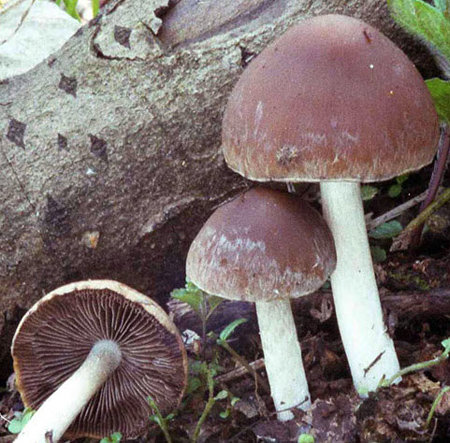
Hat:
In youth, the cap of the mushroom has a semi-spherical shape. The mushroom cap is quite compact. With age, the cap opens and becomes almost open. The diameter of the cap is from three to six centimeters. In mature mushrooms, the edges of the cap, initially picturesquely overgrown with a light fringe - the remnants of the bedspread, often crack, especially in dry weather. In the center of the cap, sometimes you can see a small tubercle, but it is extremely rare and mainly in thin-meat specimens. The surface of the cap has the same variable color as that of most fungi of this genus. The color changes easily under the influence of weather conditions. As the name suggests, the mushroom can take on almost all shades of gray and brown. In dry weather, the cap completely fades to a yellowish, clay color. The color zoning is quite pronounced.
Pulp:
The pulp is thick, whitish, watery, brittle pulp has a pleasant mushroom aroma. The flesh is brownish in color, when it dries, it turns white.
Plates: frequent, adherent, wide enough. In youth, the plates are light cream in color. In adult mushrooms, the plates from mature spores take on a dark, almost brown or black color. At the edges of the plate retain a light shade.
Spore Powder:
dark brown.
Leg:
When compared with other representatives of the Psatirella genus, the leg of the Gray-brown Psatirella is quite thick. The height of the leg is from four to eight centimeters, the thickness is up to 0.8 cm. The cylindrical leg, as a rule, is hollow inside, even, whitish. The leg is located in the center of the cap. At the base, the leg is pubescent, white, at the plates with a white powdery bloom. The surface of the leg is covered with scales of the same color as the leg.
Spreading:
The fruiting period of this mushroom begins in the first half of May. Psatirella is found gray-brown on decaying wood. It grows in relatively scattered groups, sometimes forming dense intergrowths. Fruiting occurs in several waves, the last wave falls in mid-October, but this is not reliable information.
Similarity:
The genus Psatirella includes a huge number of species, extremely variable in appearance, so it is simply impossible to understand their similarity. In May, this species is much easier to identify as there is little competition.
Edibility:
the mushroom is unconditionally edible.
Description of psatirella Candoll
In young psatirella Candoll, the cap has a bell-shaped shape, over time it becomes relatively open, while a smooth slight elevation remains in the center. The diameter of the cap ranges from 3 to 7 centimeters. The color of the cap varies from white to yellow-brown. There are specific flakes along the edges of the cap, which are the remains of the bedspread.
The pulp is brittle, thin, whitish-brown in color. The pulp has a pleasant mushroom aroma. The plates of young fruiting bodies are grayish in color; as the fungus matures, they become darker and reach a dark brown color. The plates are densely planted, they grow to the stem.
Spore powder of purple-brown color, almost black. The leg is cylindrical, hollow, with a small fluff at the bottom. The color of the leg is whitish-cream. The leg length is 7-10 centimeters with a thickness of 0.4-0.8 centimeters.
Spread of Candoll's false-horns
These mushrooms bear fruit from May until autumn. They grow in deciduous and mixed forests, as well as in parks and gardens. You can find Candoll's psatirella on the stumps and roots of deciduous trees. They grow in numerous groups.
With the onset of summer, Candoll's false heaps begin to compete for territory with shimmering dung beetles. And the dung beetles win, they choose the sunny side, and Candoll's psatirella grows in the shade.
Edible psatirella Candoll
Psatirella Candolla in old sources was referred to as inedible and even poisonous species, but today it is believed that they can be eaten after long boiling, therefore they are classified as conditionally edible mushrooms.
Similarity to other mushrooms
A distinctive feature of Candoll's mushroom is the remains of the bedspread present on the edges of the cap. But sometimes the remains of the bedspread are not preserved, in this case Candolle's psatirella is distinguished from different types of mushrooms by the places of growth - the former grows on dead wood, in numerous groups. In addition, Candoll's mushroom does not have a clearly defined ring on the leg.
Psatirella Candolla differs from representatives of the genus Agrocybe in a darker color of spore powder. But it should be borne in mind that Candoll's mushrooms are very changeable mushrooms, they can have completely different colors, which depends on the temperature, humidity and places where the fruit chalk grows. However, Candoll's mushrooms are completely different from the popular, edible mushrooms.
Other mushrooms of this genus
Psatirella gray-brown has a spherical cap at a young age, but then it opens and becomes almost prostrate. The hat is small - 3-6 centimeters in diameter.In young mushrooms, the edges of the caps are covered with a fringe, which is the remnants of a bedspread.
In dry weather, the caps often crack. A small tubercle sometimes remains in the center of the cap, but it can be seen very rarely, as a rule, in thin-fleshy fruit chalk. The color of the cap is very variable, it depends on the weather conditions. In color, any shades of brown and gray can be observed. In dry weather, the cap generally fades and turns yellow. The height of the leg is 4-8 centimeters, and the diameter reaches 0.8 centimeters, which is quite a lot in comparison with other types of psatirella. The leg is flat, cylindrical, whitish in color, its surface is covered with scales.
Psatirella gray-brown begins to bear fruit in early May. These mushrooms grow on decaying wood. They settle in rather scattered groups, sometimes they can grow together with each other. Fruiting occurs in waves, the last stage is observed in mid-October. The fungus is an edible member of the genus.
Psatirella is water-loving, she is spherical psatirella has a cap with a diameter of 2-5 centimeters. The pulp is thin, watery, brown in color, with a bitter taste, without a pronounced odor.
Psatirella water-loving bears fruit from September to November. Inhabits the remains of deciduous wood, in a more rare case, it is found on needles. This is an inedible species.
As it grows, the cap changes from bell-shaped to almost flat, with a rounded tubercle in the central part and cracking edges. The skin is dry, smooth. The color of the cap is dark brown or yellow-brown. The length of the leg is 4-8 centimeters, with a diameter of 0.5-0.8 centimeters. The leg is hollow inside, often curved. The surface of the leg is silky, its lower part is light brown with a powdery coating of white.
Description of psatirella globular
In young mushrooms, the shape of the cap is convex, hemispherical, sometimes bell-shaped, but as it grows, it opens and becomes half-open. There are often scraps of bedspreads along the edges of the cap. The diameter of the cap is small - from 2 to 6 centimeters. The structure of the cap is hygrophane, that is, it absorbs moisture. The color of the cap is very dependent on the humidity of the weather.
In rainy weather, the color of the hat is chocolate, and in dry weather it becomes creamy. The colors are often zoned.
The color of the flesh is whitish-cream. The pulp does not have a special taste and smell. The pulp is relatively tough, fragile, thin. The plates are adherent, often located, in young specimens of light color, but when the spores mature, the plates darken and turn dark brown. In damp weather, droplets of liquid may come out of the plates. The color of the spore powder is violet-brown.
The leg is smooth, although hollow inside, but rather dense. The height of the leg reaches 3-8 centimeters, with a thickness of no more than 0.7 cm. The color of the leg is whitish. There is a false ring at the top of the leg. Curved legs are common. The upper part of the leg is covered with a mealy bloom, and the lower part is light brown.
Spread of psatirella globular
These mushrooms grow on woody remains. They can be found on tree stumps in deciduous and coniferous forests, and near tree stumps in damp places. Spherical psatirella settle in large colonies, while uniting in bundles. Fruiting time lasts from June to October.
Edible psatirella globular
Psatirella globular is not considered a poisonous mushroom, but it is not considered edible either. It has no culinary value.
Similarity to other mushrooms
Psatirella globular differs from other representatives of the genus Psatirella in the brown color of the cap and in the places of growth.
Psatirella globular resembles gray-brown psatirella, but the latter is larger and grows less massively. The summer honey agaric also has a hygrophilous hat and a similar color, but there are quite a few differences in this case.
Bordered gallerina is a small brown fungus, which also has common features with globular psatirella, but the main difference is the color of the spore powder - in bordered gallerina it is rusty brown, and in psatirella, as noted, it is violet-brown.
Other mushrooms of the genus
Psatirella wadded has a conical cap at a young age, and with age it opens and reaches almost to the open. The cap is very cracked, and white flesh can be seen from under the dark skin, which makes the mushroom seem cottony.
The skin of the cap is brownish-gray. And the bottom of the hat is white. There may be remnants of a white blanket around the edges of the cap. The leg is cylindrical in shape, 3-6 centimeters high, with a width of 0.5 centimeters. The upper part of the leg is narrower, white in color, and darker at the bottom. The leg is covered with small scales.
Psatirella cotton is not very common. Typically, these mushrooms grow in dry spruce forests. They bear fruit around the middle of autumn. They settle in large numbers, in large groups. There is no information about the edibility of the Pasatirella, most likely it is classified as an inedible species.
Psatirella Candolla or Candoll's pseudofoam has a bell-shaped cap at a young age, then it becomes relatively open with a small tubercle in the center. The diameter of the cap is 3-7 cm. The color of the cap varies from white to yellow-brown.
White flakes hang around the edges of the cap - the remains of the bedspread. The leg is cylindrical, hollow, slightly pubescent in the lower part. The color of the leg is whitish-cream. Its length is 7-10 centimeters with a thickness of 0.4-0.8 centimeters.
Psatirella Condole bears fruit from May to early autumn. These mushrooms grow in mixed and deciduous forests, settling mainly on stumps and roots of deciduous trees. They grow in large groups. In old sources, these mushrooms appear as inedible and even poisonous, but in modern literature they are considered quite edible mushrooms that need preliminary boiling.
Morphology
The fruiting bodies are small or medium-sized, with a central stem position.
The cap is thin, hygrophane, at first spherical, bell-shaped or cone-shaped, can open up to flat, the edges are often grooved, the color is from whitish to various brown shades.
The pulp is thin, fragile.
The stem is long and thin, brittle, fibrous, with a cavity, usually the same color as the cap or lighter in color. The surface can be felt or scaly.
The plates are adherent or loose, at first light, then darken and become brown, violet-brown or black, usually with a lighter edge.
The remains of the bedspread are noticeable on the surface and especially along the edges of the cap, cobweb or filmy, the ring and volva are usually absent, there is rarely a ring on the leg.
Dark brown, purple or almost black spore powder.
Spores are dark purple to black, usually smooth, with occasional germination. There are cheilocystids, their shape can be varied: bottle-shaped, saccular, clavate, with a coracoid outgrowth, sometimes inlaid with crystals.
Differences
This variety has distinctive characteristics. The cocoon, which remains after birth, is on the hat of the fruiting body. If these remains of the blanket are not present, then it is necessary to study the place of growth. Mushrooms settle on dead areas of trees, in particular on stumps. Also, there is no ring on the base.
If we compare Candoll, for example, with Agrotsibe, then the following should be said. Our variety has a darker spore powder. And this variety differs from other psatirella in its large size and light tone.
Also, the peculiar variability of Candoll should not be overlooked. External data may change depending on climatic conditions, temperature conditions in the morning and evening hours. Age and habitat are of no small importance. But you should know for sure that you will not confuse this species with edible mushrooms.

